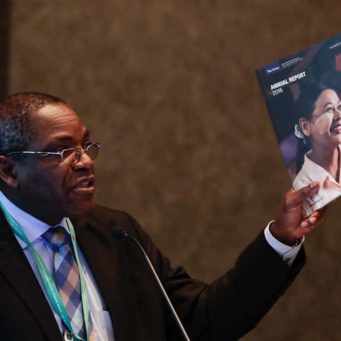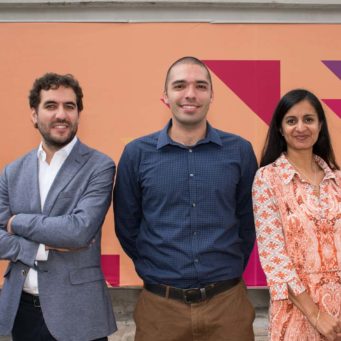Welcome
I am very proud to share with you The Union’s Annual Report for 2017, which presents updates on our most recent project work and documentation of our impact around the world. For every highlight mentioned in this report, there are hundreds of other activities that are helping the world’s most vulnerable live their best lives.
Read MoreDuring my first year as President of The Union – and the 97th of the organisation’s existence – I was struck by the commitment of our members and staff to its founding principles, and how these ambitious goals still resonate and drive us today.
Read MoreThe first global health organisation
The Union is a global scientific organisation with the mission to improve health among people living in poverty. We do that by conducting scientific research, working with governments and other agencies to translate research into better health for people around the world, and delivering projects directly in the field. The Union is made up of a global membership body of people who help to advance our mission, and a scientific institute that implements public health projects within countries. For close to 100 years, we have been leaders in the fight against some of the world’s biggest killers, including tuberculosis, lung diseases and tobacco use.
KNOW.
We conduct research to provide evidence for public health policy and practice.
SHARE.
We disseminate scientific knowledge to strengthen public health programmes.
ACT.
We deliver services and conduct advocacy to safeguard people’s health.
43,000
Myanmar
43,000 people screened and referred for testing
190k
India
190,000 sputum samples collected and transported
48,942
Zimbabwe
48,942 people from high-risk populations screened for TB
Global impact in 2017
-
Union Member Network
-
Union Offices
-
Technical Assistance
-
Research Locations
-
Courses & conferences
Our Work

Tuberculosis
TB is a curable and treatable disease – yet it is the leading infectious disease killer worldwide, accounting for 1.7 million deaths in 2016 alone, according to the 2017 Global TB Report. An additional 10.4 million people fell ill with TB in 2016. Many of those people struggle – for reasons ranging from gaps in research and development and insufficient or underfunded health services, to long and difficult treatments and stigma – to receive the treatment they need.
The Union works to accelerate progress towards the global elimination of TB. We do this by supporting high-quality, accessible prevention and care, contributing to and expanding the evidence base, disseminating research and assisting in the implementation of new knowledge into policy and practice. We advocate for the policies and actions that lead to the elimination of TB – and drive others to do the same.
220K
People showing TB symptoms identified and tested in India
48,942
High-risk Zimbabwe residents screened for TB
240K
Number of health information talks facilitated in Myanmar

MULTIDRUG-RESISTANT TUBERCULOSIS
Drug-resistant strains of TB are on the rise, accounting for an estimated 600,000 new cases in 2016. Treatment for MDR-TB is long, comes with side effects that are difficult for patients to endure and is expensive. WHO estimates show that only one in five people needing treatment for MDR-TB actually receive it and only half of those treated are cured.
The Union provides practical and experience-based support to national TB programmes. We advocate for increased research and development, conduct clinical trials to reduce treatment time and improve outcomes for patients in countries with the highest burdens of disease.
30
Countries assisted with transition and implementation to the shortened MDR-TB regimen
528
Number of participants trained through 16 Union courses on multidrug-resistant TB
11
Active sites in seven countries where Stage 2 of the STREAM clinical trial is underway

Child Tuberculosis
An estimated one million children under the age of 15 become sick with TB each year. Of those, 239,000 — nearly one in four — die. Children with TB rarely die when they receive standard treatment for the disease, but 90 percent of children who died from TB worldwide went untreated.
The Union aims to reduce the burden of child TB, particularly in high-burden settings and among those living in poverty. We develop, test, implement and scale up routine screening of child contacts of people with TB for case finding and for provision of preventive therapy to eligible children. We run observational studies and ensure children are included in clinical trials that target diagnostics, vaccines and treatment of disease and latent infection.
95%
Success rate in treating children diagnosed with TB in Uganda
2,000
Nearly 2,000 children enrolled in the TITI study on preventive therapy
1,547
Children treated through The Union’s DETECT Child TB project

TB-HIV-Diabetes
TB is an opportunistic infection that affects those with reduced immune function at much greater rates. Diabetes triples a person’s risk of developing TB. People living with HIV are 16-27 times more likely to develop TB than a person without. TB accounts for nearly 40 percent of deaths among people with HIV.
The Union develops, tests, implements and scales up models of care for co-morbid conditions that increase the risk of developing TB, are prevalent in high TB burden settings, or that adversely affect TB treatment outcomes. The Union’s work into TB co-infections is particularly focused on HIV and diabetes.
219,765
People from high-risk populations screened for tuberculosis in DR Congo
29,562
People living with HIV receiving ART through the IHC Programme in Myanmar
5,565
People with tuberculosis screened for diabetes in Zimbabwe and Uganda

Lung health and Non-communicable diseases
Every year, 65 million people suffer from chronic obstructive pulmonary disease and three million die from it, making it the third leading cause of death worldwide. In addition, 1.6 million people die from lung cancer, more than any other cancer, 334 million people suffer from asthma, the most common chronic disease of childhood, and pneumonia kills millions of people, making it a leading cause of death in the very young and very old.
The Union calls for policies and actions that contribute to improved lung health globally. We provide a global platform for the latest research on all aspects of lung health through the Union World Conference on Lung Health, Region Conferences and two scientific, peer-reviewed journals. We promote the importance of poverty reduction and address the social determinants of health to improve health outcomes worldwide.
1,400+
More than 1,400 abstracts and sessions presented at the Union World Conference
32
Abstracts and articles on lung health and NCDs were published in Union journals
9
Research and opinion papers on lung health and NCDs authored or co-authored by Union experts

Tobacco Control
Tobacco is a primary driver of today’s dramatic rise in chronic non-communicable disease, killing seven million people per year, a figure that is expected to rise to eight million by 2030, mostly in low- and middle-income countries. Unless urgent action is taken to reverse this trend, tobacco-related disease is forecast to result in one billion premature deaths worldwide during the 21st century.
The Union works with a network of grantees in 21 countries to reduce the prevalence of tobacco use in high-burden countries and among people living in poverty. We assist countries with the adoption and implementation of tobacco control policies recommended by WHO and we support prevention efforts focused on stopping individuals from initiating use of all forms of tobacco products.
UNION SUPPORT FOR TOBACCO CONTROL HAS IMPACTED:
3.33BN
People in 36 countries through smoke-free laws
1.18BN
People in seven countries where tobacco industry interference in government now faces restrictions
3.87BN
People in 16 countries through higher tobacco tax
Financial Report
Fiscal year 2017
- Total net result for the year 2017 was a deficit of 1.318 million euros compared to a surplus of 0.349 million euros in 2016.
- Total revenue was 51.470 million euros compared to 51.776 million euros in 2016
- Total expenditure was 52.789 million euros compared to 51.426 million euros in 2016
- Revenue from grants, gifts and operating grants amounted to 39.5 million euros compared to 42.8 million euros in 2016.
Union offices
-
Headquarters
68 Boulevard Saint-Michel
75006 Paris
France -
Asia pacific
146 Robinson Road, #06-01
068909 Singapore
Singapore -
China
151-52No. 1 Unit – No.6 Building
No.1 Xindong Road
Chaoyang district
100600 Beijing
China -
DR Congo
90 A/B Boulevard du 30 juin
BP 627 Kinshasa-Gombe
DR Congo -
Europe
PO Box 13730
Musselburgh
EH21 9AY
United Kingdom -
Mexico
Rio Danubio 49
Colonia Cuauhtémoc
06500 Mexico DF
Mexico -
Myanmar
No.36, 27th Street between 72nd & 73rd Street
Chan Aye Thar Zan, Mandalay
Myanmar -
Peru
Jirón Monterrey 341 oficina 1002
Urbanización Chacarilla del Estanque
Santiago de Surco, Lima
Peru -
South-east Asia
C-6, Qutub Institutional Area
110016 New Delhi
India -
Uganda
Plot 2, Lourdel Road
Nakasero Hill Kampala
P.O. Box 16094
Wandegeya
Uganda -
Zimbabwe
13 Van Praagh Avenue
Milton Park, Harare
Zimbabwe





